by Rick Allen
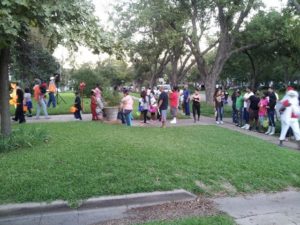 It starts as a trickle, within a few minutes it becomes a flood and within an hour or so it is gone. No, I am not writing about Waco Creek at the height of a Texas flash flood. I am describing the visceral experience that we who live on Colcord Avenue call “Halloween on Colcord.”
It starts as a trickle, within a few minutes it becomes a flood and within an hour or so it is gone. No, I am not writing about Waco Creek at the height of a Texas flash flood. I am describing the visceral experience that we who live on Colcord Avenue call “Halloween on Colcord.”
Only a decade ago, the numbers were high but manageable. Five hundred to eight hundred trick or treaters plus their parents would visit our stretch of Colcord for a couple of hours once a year. No big deal…but then we began to ask our neighbors in other neighborhoods about how BIG Halloween had become. “Oh yes”, they would exclaim, “We went from 20 to 30 trick or treaters this year”. We would eye them suspiciously…Were they even home? Were they turning off their light at 7:00pm? Had they run out of the whole bag of 25 Snickers? When we regaled relatives in Omaha of our fright night experience of hundreds of munchkins and their parents in 2 hours, we would be derided for embellishing our stories with Texas braggadocio.
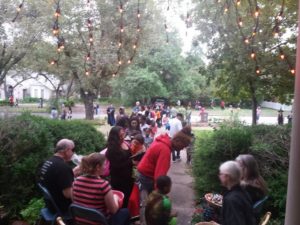 Then it really took off. About ten years ago, Ryan and Kristen R. enlisted their Sunday school class to do a hot dog give away and outdoor carnival. The first year, they gave away 500 dogs with chips and a drink. The next year…the word was out. People began car pooling their kids to Colcord. We upped the ante to prepare for the onslaught. By 5 years ago we were handing out over a thousand pieces of candy in 2 hours. We called in reinforcements; first from the neighborhood, then, HEB and friends from across the city. We set up candy stations with shifts of 30 minutes as we would wear out handing a child a piece of candy and commenting on how lovely their witch costume or Spiderman costume was. We enlisted the City of Waco to supply barriers to block off 3 blocks for the children’s safety. Last year, the Good Neighbor House (who took over the hot dog grilling) handed out over 800 hot dogs. The Capps, at the head of the blocked off street, handed out 2000 pieces of candy. We ran out of candy and wore out five adults by 7:30. Our final bag count was 1,550 pieces. Yes, from 5:30 when the two to three year olds come with mom to 7:00 when kids come running in groups of five to seven to get in line to 7:30 when we darken the whole house to let the stragglers know that we are bereft, empty and exhausted of candy supplies, it comes and goes. By 8:00 we secretively wander out to open the barricades once more and life returns to “normal” on Colcord.
Then it really took off. About ten years ago, Ryan and Kristen R. enlisted their Sunday school class to do a hot dog give away and outdoor carnival. The first year, they gave away 500 dogs with chips and a drink. The next year…the word was out. People began car pooling their kids to Colcord. We upped the ante to prepare for the onslaught. By 5 years ago we were handing out over a thousand pieces of candy in 2 hours. We called in reinforcements; first from the neighborhood, then, HEB and friends from across the city. We set up candy stations with shifts of 30 minutes as we would wear out handing a child a piece of candy and commenting on how lovely their witch costume or Spiderman costume was. We enlisted the City of Waco to supply barriers to block off 3 blocks for the children’s safety. Last year, the Good Neighbor House (who took over the hot dog grilling) handed out over 800 hot dogs. The Capps, at the head of the blocked off street, handed out 2000 pieces of candy. We ran out of candy and wore out five adults by 7:30. Our final bag count was 1,550 pieces. Yes, from 5:30 when the two to three year olds come with mom to 7:00 when kids come running in groups of five to seven to get in line to 7:30 when we darken the whole house to let the stragglers know that we are bereft, empty and exhausted of candy supplies, it comes and goes. By 8:00 we secretively wander out to open the barricades once more and life returns to “normal” on Colcord.
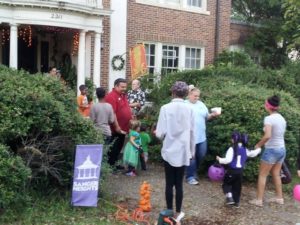 You may ask why? Why us? Why continue? Our church has been teaching us adults more about hospitality and doing for the least of these with no thought of earthly or spiritual gain…maybe that is it. I know I do it because there is no delight like seeing wee ones dressed up in costumes and taking their first tentative steps at socialization by saying, “trick or treat” and then after the candy drops into their bucket, saying, “thank you”.
You may ask why? Why us? Why continue? Our church has been teaching us adults more about hospitality and doing for the least of these with no thought of earthly or spiritual gain…maybe that is it. I know I do it because there is no delight like seeing wee ones dressed up in costumes and taking their first tentative steps at socialization by saying, “trick or treat” and then after the candy drops into their bucket, saying, “thank you”.
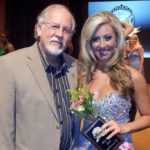 Rick Allen has worn many hats since coming to Waco in 1982. He has been a history and English teacher, social worker, therapist, special educator, school counselor, Dean of Students, Waco City Councilman, landscaper, xeriscaper, pedicab entrepreneur, B&B host, board member, Sunday school teacher, junior college instructor, MHMR curriculum writer, public speaker, blogger and dad.
Rick Allen has worn many hats since coming to Waco in 1982. He has been a history and English teacher, social worker, therapist, special educator, school counselor, Dean of Students, Waco City Councilman, landscaper, xeriscaper, pedicab entrepreneur, B&B host, board member, Sunday school teacher, junior college instructor, MHMR curriculum writer, public speaker, blogger and dad.
The Act Locally Waco blog publishes posts with a connection to these aspirations for Waco. If you are interested in writing for the Act Locally Waco Blog, please email [email protected] for more information.
By Diego Loredo
I know a lot of college students have heard this from their professors. “Make a portfolio and LinkedIn! It’ll help you get a job when you graduate.” I heard this way too many times during my freshman year here at UNT. But after making both an online (and physical) portfolio and a LinkedIn account, I think my professors were right about how important they are.
Being a public relations major, making a portfolio and a LinkedIn account are things that my professors constantly reminded me to do. I never really put much thought into either of them until sophomore year when I had assignments requiring me to do those things. But I’m actually glad that my professors made me create a portfolio and LinkedIn account. Although they still need work, I now have a great starting point.
For those who don’t know what a portfolio is, it’s where you put all of your professional work in one place to showcase to any possible employers. This can be from internships, major assignments from any classes, or any work relevant to what you’re trying to get hired to do. For me, I have work that I’ve done in my public relations classes, work that I’ve done with Minnie’s Food Pantry in Plano, and even my resume. It seems tedious to do, but it can really impress your future employers and can land you that dream job if you do it right.
I have a physical portfolio that I made last semester in my PR class and an online portfolio as well. My physical portfolio basically has all of my work organized in a binder and separated by dividers. The link to my online portfolio is here. Although they’re not perfect, feel free to use them as an example.
LinkedIn is another way to showcase your skills, work and expand your network. I know some students think LinkedIn is a waste of time, but it all depends on how you use it. I currently do not have many connections since I’ve only began working on it recently, but I’ve already learned about its benefits from my professors. My social media professor is always telling us about how LinkedIn has landed former students jobs.
A lot of students think that you just make a LinkedIn then sit back and watch it land you a job. But you have to constantly monitor it and keep it updated. You can search for available jobs related to your major, connect with professionals who specialize in the same things you do, and much more. I’ve only started working on my LinkedIn account late into my sophomore year, but I recommend working on it during freshman year if you can. Don’t just connect with random people, but connect with those that you know or can help you land a job. Also, feel free to connect with me if you would like to here.
I know making a portfolio and LinkedIn account sound boring, but they can be extremely useful when you’re looking for a job. It’s true that they can be more useful for some majors and not as useful for others, but I believe all students should have one anyway. I still need to work on mine and get more experience, but I at least know how to use them and how valuable they are.
 Diego Loredo is a junior at the University of North Texas and is majoring in public relations. He graduated from University High School in 2014. He plans on working in sports PR or for a nonprofit. He loves to play soccer and is a huge FC Dallas fan. Have something that you would like Diego to write about or have a problem that you would like to ask him? Shoot him an email at [email protected].
Diego Loredo is a junior at the University of North Texas and is majoring in public relations. He graduated from University High School in 2014. He plans on working in sports PR or for a nonprofit. He loves to play soccer and is a huge FC Dallas fan. Have something that you would like Diego to write about or have a problem that you would like to ask him? Shoot him an email at [email protected].
The Act Locally Waco blog publishes posts with a connection to these aspirations for Waco. If you are interested in writing for the Act Locally Waco Blog, please email [email protected] for more information.
By Brittany Davis
I hardly make it to the door of the school most mornings before I am greeted by a barrage of questions from eager seniors. This is the time of year when their ‘when I grow up’ dreams take the first step into actuality. This is my favorite time of year. Before the applications, paperwork and testing can begin there are several conversations that seem to be on replay in my office.
Choosing a College is like buying a car
After working at higher education institutions for the past eight years I have seen firsthand how we try to sell students on our schools however we can; it is a business after all. I once had a student tell me that what sold him on our school was that we had a build your own waffle station in the dining hall….my point being students often get caught up in the details — the fresh strawberries and whipped cream instead of the academics and degrees. So — to reel students back in from the beautifully glossy pages of college catalogs and the build your own waffle stations — I compare choosing a college to buying a car. You wouldn’t go into a dealership unprepared without doing your research or having an idea of what you want, and the same should go for choosing an institution where you will spend the next two to four years. Students should be prepared to answer the following questions before choosing a college:
- Big school or small school?
- Public or private?
- How far are you willing to go from home?
- What teacher to student ratio will you be most successful in?
College major or degree plan is a major factor in this equation, yes, but according to the National Center for Educational Statistics roughly 80% of students change their major at least once. It is just as important for the campus as a whole to be a good fit. A resource I love for this is the Big Future College Search created by The College Board. It asks students all the hard questions and then provides them with a list of schools that fit their criteria.
Explore Your Career Interest
Students feel pressured into being definitive in their major choice from day one of senior year and often times that can be counterintuitive as they may overlook an opportunity for which they may be better suited. We had 4 seniors last year that had their minds made up about studying dental hygiene and after visiting campus to tour the program, one of the four was still committed to the program, and the other three couldn’t even finish the tour before they were pale faced and ready to toss their lunch. Which is why I encourage students not only to take campus tours when at all possible, but also take every opportunity to explore his or her career interest. We are so lucky to live in a community where businesses and community members rally around our students and are eager to help them. Students can reach out to professionals in our community to shadow them and ask them questions about their field of interest. Academic Advisors at your campus can also help students get connected. Take the opportunity to get connected, volunteer your time, and you will not only be more sure about your major but also more motivated to complete a degree you are truly interested in.
Ask for help, and ask often!
The college application and financial aid process is a challenge to navigate and can differ by college. For a first generation college student, this can be daunting and discourage them from college altogether. Thankfully in Waco, we have several campus-based as well as community engagement pieces that are in place to help students overcome these hurdles. Most campuses in our area have a designated college counselor or advisor. University High, Waco High, and La Vega High School have the Project Link program, MAC foundation, and CAP program is also available to McLennan County students. These programs help students through every step of the application process. However, for many students, the application process is just one of the many barriers they will have to overcome to be successful college students and eventual graduates. Just like high schools, colleges also have student-focused resources to help students be successful. After all, colleges are in the business of getting students graduated and if there are significant barriers inhibiting students from completing degree plans it is in their best interest to offer resources to help them be successful. Most colleges offer, at the very least, supplemental instruction, writing labs, counseling services, and career centers. All of these services are completely free to students! Community Colleges often offer specialized services as they typically serve more non-traditional students with unique barriers such as on-site daycare, student care clinics, and crisis intervention services. Ask for help students, these services are grossly underutilized in most schools. The tools and services are there for you to be successful, you just have to ask!
Your education is an opportunity to change your corner of the world, be brave and make bold decisions with your future!
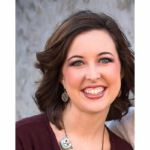 Brittany Davis is an Academic Advisor at University High School. She was raised in a small Texas town and is a recent transplant to Waco, and loving it! As a first generation college student, Mrs. Davis understands firsthand how overwhelming and intimidating the process can be, and strives to use her 9 years of higher education experience to help students feel capable, brave and significant in setting out to achieve their goals. Her favorite thing to do in Waco is going to documentaries on Mondays at the Hippodrome with friends.
Brittany Davis is an Academic Advisor at University High School. She was raised in a small Texas town and is a recent transplant to Waco, and loving it! As a first generation college student, Mrs. Davis understands firsthand how overwhelming and intimidating the process can be, and strives to use her 9 years of higher education experience to help students feel capable, brave and significant in setting out to achieve their goals. Her favorite thing to do in Waco is going to documentaries on Mondays at the Hippodrome with friends.
The Act Locally Waco blog publishes posts with a connection to these Aspirations for Waco. If you are interested in writing for the Act Locally Waco Blog, please email [email protected] for more information.
By Jennifer Alumbaugh
I have a confession: I’m not entirely certain that the pursuit of happiness is a necessarily useful or wholly possible endeavor.
Now, before you grab your pitchforks or rotten tomatoes, stay with me a while inside this idea. I’m a much bigger fan of the pursuit of joy. You might think I’m just arguing semantics. And you may hold to that thought by the time you reach the end of this blog. But I propose that the difference is significant and goes much deeper than mere language.
Clarification: I’m not entirely certain that happiness—pure, unadulterated, levity—is attainable for everyone.
Yes. That’s better. A more true representation of my thesis.
Caveat: I am someone who has lived with chronic grief her whole life, a pervasive soul sorrow that has cast a shadow over so many moments. My exploration is absolutely colored by this experience. I also write as someone who has carried an immense amount of shame and guilt around my difficulty with experiencing happiness. I realize that there may be some readers who have difficulty grasping this notion and for that, I am sincerely grateful.
It’s important for us to take a look at some of the mechanics that go into how people feel the emotions they encounter. Personality types and nervous system settings influence the ways in which we experience the world. Some people self-identify—through a process of self-discovery—as Empaths or Highly Sensitive individuals. This is a personality type, a biological setting, people are either prone to or not. These individuals have emotional feeling receptors which operate at a much broader frequency than others of us. They can attune to what others are feeling, experiencing the feeling with another vividly and in real time. A person’s capacity for compassion also influences happiness. Identity and lived-experiences are significant contributors or detractors of happiness—if one moves about the world with little conflict regarding their personhood, this is a kind of privilege that contributes to increased levels of happiness while those for whom safety, rights, and access to life’s necessities and bounty are limited often exhibit difficulties with sustaining happiness. Certainly our location—geographically and socially—influences our ability to experience happiness as do our experiences in the world from freedoms, to traumas, to exposure to violence, to attachments, to opportunities, to privileges.
The teachings tell us that we could be happy if we just choose to be. Choice. Such a tricky word. There is a great deal about our identities and our experiences that we have no agency over to accept or decline or even change. Some of us have more wiggle room than others in changing certain aspects of our circumstances—but even those with the most resources are limited, fundamentally, in what aspects of self and life they can alter. And while all of us have some choices, we don’t all have the same choices or the same access to changing our circumstances.
As a white woman I can choose to engage—or not—with news and social justice issues around race; my Black kindred do not have this choice. They cannot decide to not be Black one day because it would be easier. As an ally, I choose to remain engaged, aware, connected, and present with feeling the viscera of race trauma in the US today. I don’t know it first hand, but empathically I remain open to the grief, sorrow, horror, outrage, and despair experienced by my friends of color.
I acknowledge that it is a choice I make to keep my self, my heart, my soul open to the effects of being aware of social (in)justices occurring in my community, my country, and globally. I realize that this choice puts me at risk for experiencing reduced instances of happiness. I could tune out. There is indeed a certain bliss that accompanies ignorance. For me, that path is not an option because it is out of line with my authentic being and becoming.
But here is the thing, in the very midst of grief, of sorrow, of pain, I continue to experience life-giving joys. While happiness is a fleeting moment, dependent up on circumstances—a job promotion, a favorite flavor of ice cream, a silly joke, reciprocated affection of a beloved—joy abides, even inside the darkest night.
Joy is a kindred of contentment, of feeling fulfilled, of deep gratitude. Joy can be dancing delight. Joy can be great belly laughter. Joy is awe-struck wonder. Joy is a heart full and over-flowing. Joy is doing what we love—a resounding satisfaction. Joy can show up in our tear-stained storms radiating rainbows.
My intention with this post is not some doomsday moratorium on happiness. My hope is that maybe we open the circle a little wider and before reposting that next “you could be happy if you really wanted to” meme, you pause a moment. Consider those in your community who are beared down in grief. Those who have survived unspeakable losses. Those who navigate the challenges of mental or medical health issues. Consider our kin in war zones and those surviving hunger and home and financial insecurities daily. Hold for a moment those who move about the world inside identities that are bullied, threatened, mocked, and misunderstood. Make some room for their difficulties with happiness and allow for the possibility of joy. Happiness is so much more luck than choice; joy is a practice.
Wherever you may be in this moment, whatever burdens you bear, whatever lightness you relish, may an extraordinary joy show up for you today, and linger a while in your heart.
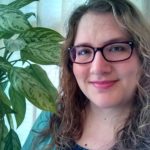 Jennifer Alumbaugh, MS is a Licensed Marriage and Family Therapist providing clinical and professional development consultation services at Enrichment Training and Counseling Solutions. She has extensive experience working with adolescent and adult survivors of psychological and spiritual abuse, trauma (sexual violence, childhood trauma, interpersonal violence); and complex PTSD. These, along with grief and loss work are her areas of specialization. Jennifer practiced as a mental health clinician throughout Los Angeles County working with children, youth, and their families from 2007-2012. In Central Texas, Jennifer has worked as a Site Coordinator with Communities in Schools of The Heart of Texas at G.W. Carver Middle School; as an independent consultant and professional development trainer; and conference speaker. In 2016 Jennifer created an implemented a therapeutic creative writing program, Brave Young Voices, at Klaras Center for Families and at the Texas Juvenile Justice Department correctional campus at Mart, TX. She may be reached at: [email protected] or 254-405-2496.
Jennifer Alumbaugh, MS is a Licensed Marriage and Family Therapist providing clinical and professional development consultation services at Enrichment Training and Counseling Solutions. She has extensive experience working with adolescent and adult survivors of psychological and spiritual abuse, trauma (sexual violence, childhood trauma, interpersonal violence); and complex PTSD. These, along with grief and loss work are her areas of specialization. Jennifer practiced as a mental health clinician throughout Los Angeles County working with children, youth, and their families from 2007-2012. In Central Texas, Jennifer has worked as a Site Coordinator with Communities in Schools of The Heart of Texas at G.W. Carver Middle School; as an independent consultant and professional development trainer; and conference speaker. In 2016 Jennifer created an implemented a therapeutic creative writing program, Brave Young Voices, at Klaras Center for Families and at the Texas Juvenile Justice Department correctional campus at Mart, TX. She may be reached at: [email protected] or 254-405-2496.
The Act Locally Waco blog publishes posts with a connection to these Aspirations for Waco. If you are interested in writing for the Act Locally Waco Blog, please email [email protected] for more information.
By Lucas Land
How do we get there from here?
Not to spoil the rest of the article, but the answer is… together.
The two major party candidates for President have spent precious little time talking about the greatest threat faced by the United States, and the rest of humanity. It’s not ISIS, immigration, health care or the economy. Climate change and environmental degradation threaten the very existence of our species on this planet. The transition away from a fossil-fuel based economy involves rethinking many of the things we take for granted in modern society. There is so much work to do that it can often feel overwhelming and impossible.
That’s when I return to a favorite quote from Wendell Berry for solace:
“The question that must be addressed is not how to care for the planet, but how to care for each of the planet’s millions of human and natural neighborhoods, each of its millions of small pieces and parcels of land, each one of which is in some precious way different from all the others.” [1]
This is why I love local politics. It’s easy to get distracted and become polarized by our national politics. It’s much harder to do that when the issues are local and the debate is with our neighbors, friends, and co-workers. When you have to see each other in the grocery store, there is a greater incentive to find common ground and build relationships across many of the lines that divide us. It’s also harder to care about polar bears than the plants and animals in our own backyard, not to mention we have more control over the latter.
So often we fall into the trap that change only happens by creating an “us versus them” narrative. One side has to be the evil corporation or corrupt government and the other are the righteous, do-gooders who are on the right side of history. This tickles our lizard brains and makes us feel better about ourselves, but in the end it creates and/or perpetuates as many problems as it solves.
I do believe that there are times and places that require us to stand up to injustice and even protest actions that are evil. We should never forget that Martin Luther King, Jr., Gandhi, and others believed non-violent civil disobedience worked, because of the inherent dignity and humanity of those they protested against.
I’ve discovered recently how much can be accomplished in our community by treating people on all sides like human beings that deserve respect, while also speaking up about what I think could make our community better. This is why we need better models and frameworks for making change in our community. One group doing this work in our community is Baylor’s Public Deliberation Initiative. They gather diverse groups of students and community members to discuss and dialogue around difficult issues (such as racial reconciliation, gun violence, and politics). Their approach to these conversations can help us listen better to each other and work towards solutions rather than deepening the divide. They will host a post-election forum November 14th at the Bobo Spiritual Life Center on “Getting American Politics Working Again.”
On November 9th, regardless of who is elected, we will still have a lot of work to do, and we will have to work with people who did not vote like us. Conversations and actions are already happening in our community about how to make our city more walkable and bike friendly . Groups in town (http://acecentex.org and http://friendsofpeacewaco.blogspot.com/ ) are tackling the challenge of a sustainable energy future for our community. Groups such as World Hunger Relief, HOT Urban Gardening Coalition, Baylor’s Campus Kitchen, and many others are working on issues related to local food, food insecurity, and health. You can find more opportunities to get involved in working on sustainability at sustainablewaco.org.
I love this “human and natural neighborhood” we call Waco, McLennan County and the Brazos watershed. Learning to love this place is the task we have been given and the only way to do it… is together.
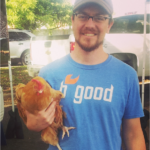 Lucas Land is an eco-theologian, urban farmer, activist, aspiring master naturalist, facilitator, musician, and writer. He is avoiding growing up by constantly learning and trying new things. He also works in Grants Management for Waco ISD. He lives with his wife, three children, flock of chickens, dog, and cat in the Sanger Heights Neighborhood in North Waco.
Lucas Land is an eco-theologian, urban farmer, activist, aspiring master naturalist, facilitator, musician, and writer. He is avoiding growing up by constantly learning and trying new things. He also works in Grants Management for Waco ISD. He lives with his wife, three children, flock of chickens, dog, and cat in the Sanger Heights Neighborhood in North Waco.
The Act Locally Waco blog publishes posts with a connection to these aspirations for Waco. If you are interested in writing for the Act Locally Waco Blog, please email [email protected] for more information.
[1] Berry, Wendell. What Are People For?: Essays. San Francisco: North Point, 1990. p. 200.
By Trey Crumpton
What journey have you taken? What journey will you take? Do you have a friend or relative who has taken a journey according to his/her faith? Might you have occasion to cross paths with someone whose faith tradition is different from yours? These are all questions which we explore in our fall exhibit at the Mayborn Museum at Baylor University. Produced by The Children’s Museum of Indianapolis and the National Geographic Society, Sacred Journeys focuses on important pilgrimages of five major world religions: Christianity, Islam, Judaism, Hinduism, and Buddhism.
It has been a privilege to listen and speak with people from our community who may think and believe differently, engaging in dialogue about our shared spirit and humanity. People journey to add experience and context to their soul, and in some cases, to fulfill tenets within their given faith. We learn together about each person’s tradition, and one might say that this “learning journey” is a sacred one—binding together those who might otherwise remain separate.
 Over the past few weeks, we have participated in several events which highlight our shared emphasis on stories. The Mayborn hosted an interfaith prayer breakfast for the opening of the exhibit, and museum staff were invited to share personal faith journeys at a Cross Cultural Dinner hosted by Baylor Spiritual Life. The panel discussion, Holy Journeys, Holy Destinations included four Baylor professors (Candi Cann, Robert Creech, Elise Edwards, and Matthew Whelan) who discussed what happens when we travel to holy places, how holy places can travel with us.
Over the past few weeks, we have participated in several events which highlight our shared emphasis on stories. The Mayborn hosted an interfaith prayer breakfast for the opening of the exhibit, and museum staff were invited to share personal faith journeys at a Cross Cultural Dinner hosted by Baylor Spiritual Life. The panel discussion, Holy Journeys, Holy Destinations included four Baylor professors (Candi Cann, Robert Creech, Elise Edwards, and Matthew Whelan) who discussed what happens when we travel to holy places, how holy places can travel with us.
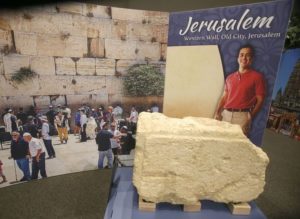 Throughout the fall, the museum will continue to host events which promote dialogue, including an Interfaith Student Panel Discussion on November 10, hosted by Baylor’s interfaith group, Better Together BU. Along with the Greater Waco Interfaith Conference, the museum will host a Festival of Faiths on October 30. The National Geographic film, Jerusalem, will play during select showings on the weekends, through the duration of the exhibit, which runs through December 31.
Throughout the fall, the museum will continue to host events which promote dialogue, including an Interfaith Student Panel Discussion on November 10, hosted by Baylor’s interfaith group, Better Together BU. Along with the Greater Waco Interfaith Conference, the museum will host a Festival of Faiths on October 30. The National Geographic film, Jerusalem, will play during select showings on the weekends, through the duration of the exhibit, which runs through December 31.
A little more about National Geographic Sacred Journeys:
Each year more than 330 million people around the world journey to sacred places as part of their religious commitments. Some seek enlightenment or healing. Others perform acts of devotion that are expressions of deep faith. The new exhibit reflects this diversity of religious and spiritual pilgrimage through immersive environments created with photography from National Geographic. Families will be able to observe, discuss, and begin to understand some of the beliefs and sacred journeys made by people around the world.
Recreated places, spaces, and events invite visitors to learn more about the history and beliefs that support spiritual practices that take place at home and within our congregations. Featured sites include:
- The Western Wall of the Second Jewish Temple in Jerusalem, Israel
- Dome of the Rock, site of Muhammad’s ascent to heaven in Jerusalem, Israel
- The Church of the Holy Sepulchre, site of Jesus’ crucifixion in Jerusalem, Israel
- The Grand Mosque in Mecca, Saudi Arabia, to which all Muslims are expected to make a pilgrimage or Hajj once in their lifetimes
- Tepeyac Hill and the Roman Catholic Basilica of Our Lady of Guadalupe in Mexico City, Mexico
- Allahabad and Sangam at the confluence of three rivers sacred to Hindus at the Ganges River in India, site of some of the largest gatherings of humans on earth
- Bodh Gaya, birthplace of Buddhism, and the Bodhi Tree where Gautama Buddha achieved enlightenment in Bihar, India
- Caves in the bluffs along the Dead Sea in Qumran, Israel where the Dead Sea Scrolls were discovered
 The exhibit will come to life through the personal stories of children and families who participate in sacred journeys or practices. Connecting with these experiences will allow visitors to learn how pilgrimage and revered artifacts reflect religious traditions and the cultures associated with those religions.
The exhibit will come to life through the personal stories of children and families who participate in sacred journeys or practices. Connecting with these experiences will allow visitors to learn how pilgrimage and revered artifacts reflect religious traditions and the cultures associated with those religions.
“The Sacred Journeys exhibit promises to be a very rewarding project. Many Americans associate the idea of pilgrimage with the Middle Ages, but in fact it is a huge reality in the present world, something that affects literally billions of people. Pilgrimage also provides a wonderful way of understanding religious impulses as they are expressed in different world faiths. So we are dealing with something richly educational, something that provides a unique way of understanding different religious traditions, but it’s also breathtaking in terms of the beautiful places and buildings that will be explored.,” says Professor Philip Jenkins, Distinguished Professor of History in the Institute for Studies of Religion at Baylor University as well as the Mayborn Museum’s spokesperson for Sacred Journeys.
 Trey Crumpton is Exhibits Manager for the Mayborn Museum Complex at Baylor University, where he has been on staff for 10 years. He has lived in Waco since 2001, and has two energetic preschoolers who love to discover. His beautiful wife Ashley is an early childhood educator, and together they are proponents of all things educational, enriching and fun. Trey loves family, friends, the outdoors, dark chocolate, good books, pizza, and good film.
Trey Crumpton is Exhibits Manager for the Mayborn Museum Complex at Baylor University, where he has been on staff for 10 years. He has lived in Waco since 2001, and has two energetic preschoolers who love to discover. His beautiful wife Ashley is an early childhood educator, and together they are proponents of all things educational, enriching and fun. Trey loves family, friends, the outdoors, dark chocolate, good books, pizza, and good film.
The Act Locally Waco blog publishes posts with a connection to these aspirations for Waco. If you are interested in writing for the Act Locally Waco Blog, please email [email protected] for more information.
By Scott Bland
Over the last 30 years there have been two trends in our educational system and the construction industry that have been slowly and steadily creating an issue that has the potential to create dramatic problems within our economy. The construction industry that is critical to our economic health is experiencing a massive talent drain that is not being renewed. Fortunately, there is a plan in place to bring talent back to the industry and reverse the stigma that has been created around jobs in construction. It’s important to first look at the two trends that created the issue.
During the last 30 plus years our education industry has been a “college or bust” model in which students were taught from the perspective that going to college after graduation was the only path to success. As a result, careers that didn’t involve a college degree were not presented as desirable paths to take after graduation. This has created a stigma against jobs in the construction industry and caused students to look at other options even if they have an interest and ability to work within the trades.
At the same time the education industry was steering students away from the construction industry, the industry itself was becoming more and more diverse and technically complicated. The process of building a home or commercial building has evolved far beyond what the shop classes of the 1970’s and 80’s were able to show students. From the miles of electrical and network wiring to the framing calculations involved in high pitched roofs and vaulted ceilings, the construction industry can no longer get by with an un-educated workforce.
What is not being taught to our high school students is the fact that there are jobs within the construction industry that pay at rates the same as or in many cases higher than jobs requiring 4 year degrees. A student graduating high school with a background in construction trades and who takes post graduate classes to receive certifications in the industry are suddenly qualified for hundreds of careers with pay ranges starting from $30 per hour and up. The lack of a talented applicant pool is so dire at this point; many trades companies will put these individuals into apprentice positions and work with them as they earn the certifications they need.
What is needed is a program within the high school system that a student who is interested in careers within the construction industry can get specific class instruction as well as hands on training in the field. We are so fortunate in Central Texas to have the Greater Waco Advanced Manufacturing Academy (GWAMA) that can serve as the home for a construction sciences program. One of the many advantages to GWAMA is that it is open to students from any district in Central Texas. The GWAMA program has already had tremendous success within the welding, metalworking, and health care industries and there is space available for a construction services division.
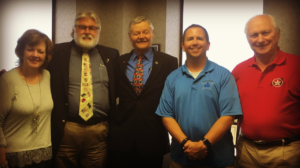
A few of the local leaders who have been working to plan the Greater Waco Construction Sciences Academy.
The program that is being proposed would begin in the 10th grade and would be exclusively taught in the classroom in that first year. The first year would be the time when the students would be exposed to all facets of the construction industry as well as being taught the basics of construction. Students would be taught the basics of plumbing, electrical, heating and air conditioning, framing, and masonry so they could begin to get a feel for their primary interest. This year would also involve receiving their OSHA certifications and CPR training to emphasize the importance of safety on the job sites.
In the second year, the students would have much more specific classroom training geared towards their primary areas of interest. At least half of their time will be spent on job sites to begin get a feel for what a career in the industry is really like. NeighborWorks Waco has dedicated a yearly construction site for students in the program to receive instruction in their second year.
In the final year the students will apply for, interview, and work within the industry on a paid internship. The students will have one day a week in the classroom and spend the other 4 days in a paid internship at a company within their primary area of interest. This is the model that companies within the industry are encouraging and the model that they will support by providing these internships. From the industry perspective, this gives them the opportunity to make sure students are being exposed to the concepts and practices that give them the best chance at being successful.
For the students within the program, they will graduate with a diploma that has endorsements from the Heart of Texas Builder’s Association, the Texas Association of Builder’s and the Waco Association of General Contractors. That endorsement is the way that a student can show a potential employer that they have training and instruction that moves them ahead of other applicants. That endorsement may also place them further ahead within an advanced certification program.
The message that needs to be out there is that the construction industry is no longer an industry to be stigmatized as a place for students that can’t make it in college. The salaries, benefits, and security of jobs in construction no longer lags behind professions requiring advanced degrees. The complexities of the industry also require students who are capable of working with their minds just as well as working with their hands.
The construction sciences program at GWAMA, if approved, will provide students with an alternate path to success from the traditional “college only” model. It will provide a reason to continue going to school for those students who have no interest or desire to go to college. For a student whose family is involved in the construction industry, it will provide a validation and sense of pride in that work which has been missing for far too long. And for the student who desires a college education but cannot see any possible way to pay the costs – consider the benefits of having a high paying job in the construction trades to earn money to pay for that college degree! This program provides a pathway to a career that can pay those tuition costs. A young person who has construction industry certifications, and a 4-year degree, and who has no student debt is a tremendous benefit to our economy. However, a young person with only a 4-year degree and who owes thousands in student loan debt is sadly far more common.
(Note: The Waco ISD Board of Trustees will be hearing an update on the Construction Academy at their October 20 board meeting.)
 Scott Bland was born and raised in Waco. He is an alumnus of Baylor University. He worked for Highland Homes in the Dallas area from 1998 to 2001, then joined the United States Secret Service as a Special Agent after the 9/11 attacks. He retired his commission in late 2006 to return to Waco and take over the family business, Jim Bland Construction, where he has served as Owner and President of the company for the last 10 years. He is currently the President of the Heart of Texas Builder’s Association as well as a member of the Board of Directors for the Greater Waco Chamber of Commerce.
Scott Bland was born and raised in Waco. He is an alumnus of Baylor University. He worked for Highland Homes in the Dallas area from 1998 to 2001, then joined the United States Secret Service as a Special Agent after the 9/11 attacks. He retired his commission in late 2006 to return to Waco and take over the family business, Jim Bland Construction, where he has served as Owner and President of the company for the last 10 years. He is currently the President of the Heart of Texas Builder’s Association as well as a member of the Board of Directors for the Greater Waco Chamber of Commerce.
The Act Locally Waco blog publishes posts with a connection to these aspirations for Waco. If you are interested in writing for the Act Locally Waco Blog, please email [email protected] for more information.
By Craig Nash
I don’t remember how old I was. Old enough to remember, I suppose. If the research I conducted on the historical conditions that led to this memory is correct, probably somewhere between three and six. It’s one of those cloudy early-life memories, the type you attach details and, more importantly, meaning to decades after it occurs. It’s also one of those random memories that isn’t constantly present, but presents itself at random times throughout my life, reminding me of how transformative the experience was, simply by virtue of its memory sticking around.
We were at the baseball field behind the school, my mom, sister and I. I want to say it was cold, but perhaps that is my mind adding editorial flourish to mimic what I was sensing. There was a crowd, but not for a game. I remember feeling out of place, like everyone but us knew the drill– when the truck would arrive, how to line up, what identification to have ready.
I remember my sister being excited, like she knew something I didn’t. When the truck arrived and backed up to the line, and it was our turn, she ran into the trailer with the paper bag as my mom told her what to put in it.
On our walk home, she took the pre-packaged foods out one-by-one to show us what we had. There’s only one thing I remember about the experience that I know is completely true, because it was so out of the ordinary. The food had generic packaging. Not “generic” in the “off brand, purchased at a discount store” sense, but “generic” in the sense that the packages and labels on the cans were white with simple black lettering identifying what was inside: Beans. Cheese. Noodles. Corn.
It was like food packages in the cartoons.
I remember being intrigued by this. If I could have explained what was going on in my mind, I would have said, “Mom, this is weird. This food doesn’t look like the kind we get in the store.” But in later years when the memory would peak back into my brain, the intrigue turned to shame as I realized what all this meant.
We were poor.
Dad worked for the Kelly Springfield Tire Company in Tyler, like most of the dads in the small town I grew up in. It was a union job, which was good when it was good, but not so good when layoffs and strikes occurred. It also meant that we were never in severe need for too long. (This wouldn’t be the case for Kelly families decades later, when the company closed the plant after demanding more and more concessions from its workers.) But the times of scarcity, though rare, were enough to leave a mark on me.
I often think about this experience as I am out and about, observing the many ways in which Wacoans pitch in to help our hungry citizens. I’m thankful there was a “safety net” for my family, just like there is for families all across our city. But I also think about the shame I felt at being in temporary poverty, what that did to my psyche, and I wonder about the future memories of children who are in perpetual poverty. This is why programs like SNAP and WIC are so important, (aside from the fact that they are proven to work.) They give parents the dignity of walking down a grocery store aisle with their children and making choices for their family, like every other family in the community.
It’s why I am thankful that school districts like Waco and La Vega ISD offer school breakfast and lunch free of charge to all students, so no child has to be singled out based on their ability to pay.
Our inclination to help is a good one. And sometimes, like when half a town loses its job due to layoffs, extraordinary measures need to be taken to get food to people in extraordinary ways. But my hope and prayer is that we will strive to find ways to get food to people in ordinary ways, that draws attention neither to the giver or the receiver, so that the memories of our children will only be those of food at the table, not how it got there.
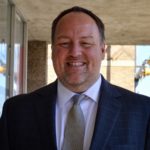 Craig Nash has lived in Waco since 2000. Since then he has worked at Baylor, been a seminary student, managed a hotel restaurant, been the “Barnes and Noble guy,” pastored a church and once again works for Baylor through the Texas Hunger Initiative. He lives with his dog Jane, religiously re-watches the same 4 series on Netflix over and over again, and considers himself an amateur country music historian.
Craig Nash has lived in Waco since 2000. Since then he has worked at Baylor, been a seminary student, managed a hotel restaurant, been the “Barnes and Noble guy,” pastored a church and once again works for Baylor through the Texas Hunger Initiative. He lives with his dog Jane, religiously re-watches the same 4 series on Netflix over and over again, and considers himself an amateur country music historian.
The Act Locally Waco blog publishes posts with a connection to these aspirations for Waco. If you are interested in writing for the Act Locally Waco Blog, please email [email protected] for more information.
By Rolando Rodriguez Soto
(This post is part of an on-going series about Downtown Waco. In a sense, Downtown is “everybody’s neighborhood.” In this series of blog posts we hope to contribute to the on-going conversation in Waco about what it takes to have a great downtown, and what we want for our own “Wacotown.” To see all the posts in this series, click here: Downtown Waco. – ABT)
The goal for revitalizing Downtown Waco is to create an all-inclusive downtown area that encourages people of all ages to visit on a regular basis. One particularly important demographic is the millennial generation, roughly defined as those who graduated from high school in the year 2000 or later. This group includes college students and young professionals.
I met with several young professionals and college students who were raised in Waco to hear what they wanted from downtown. I focused on native Wacoans to get the perspective of people who have been exposed to downtown before and after the recent growth in downtown development.
Unsurprisingly, different people want and need different things from downtown – different things motivate them to make the trip to Waco’s city center. Some prefer a quiet place to study, some want to relax during the day with family, while others prefer a fun environment that can last all night.
Creating a livable downtown will mean establishing a balanced environment that appeals to a variety of personalities and accommodates different schedules. For example, Anthony Albiter and Angeli Mondragon put a high priority on daytime activities they can enjoy with their families. Richard Fuentes and Leonor Campos, on the other hand, crave more nightlife with music and entertainment.
Anthony was raised in the north Waco area. He received his associate’s degree at McLennan Community College, and he is currently a bank teller. Even though he attended high school at A. J. Moore Academy (now Indian Spring Middle School), he did not necessarily experience most of downtown until recently.
“Downtown would benefit from having more hangout spots besides bars because some people don’t really enjoy bars,” Albiter said. “Or having a plaza so families can go enjoy a nice walk.”
Angeli was raised in the south Waco area near downtown. She now lives in the Sanger Heights neighborhood and has two children—one 2 year old and one 10 month old. She values the walkability of downtown because she has to travel with a toddler and a baby.
“I usually go to downtown for food or Spice Village,” Angeli says. “I’d probably go more often if there were more things for me do with the kids. I would love if there was a festival for toddlers or a place like My Little Play Palace in downtown to tire out the kids, so I can go shopping afterwards.”
Both Anthony and Angeli mentioned that having opportunities like the Waco Wonderland, Cameron Park and the food trucks are great, and there could still be more regular activities during the day for a family to enjoy.
In contrast, to Anthony and Angeli’s familial perspective, Richard and Leonor are more attracted to a downtown area with a dynamic nightlife.
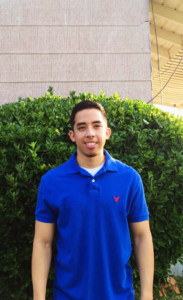
Richard Fuentes
Richard grew up in the North Waco neighborhood, and he currently attends Baylor University. He particularly enjoys First Fridays when businesses stay open late during the first Friday of every month. Fuentes often goes with friends to grab a drink at a bar in downtown.
“I would like to see more shops and restaurants open for business, especially during the night,” Fuentes said. “An ideal downtown Waco would be a place where you can go during a night out and enjoy the whole night with lights illuminating downtown to give people the option to walk boundlessly almost like a mini city within Waco.”
Leonor was raised in Lacy Lakeview near Waco, and she currently lives near the downtown area. She values the historic and art aspects of downtown as well as the opportunity for live music and entertainment.
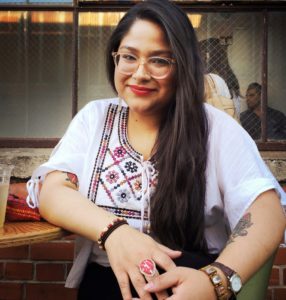
Leonor Campos
“Downtown is slowly getting better with festivals and activities because each year they realize what didn’t work and what activities are getting more popular,” Campos said. “Before there were only club style bars, and now we are starting to have more live music.”
For Teresa Soto and Josh Arias it is not the businesses or restaurants offered during the day nor the bars or clubs open during the night that drew them from Hewitt to downtown — it was Pokémon Go.
“Before Pokemon Go, I wouldn’t go to downtown,” Teresa says. “Pokemon Go brought me to downtown, which made me more comfortable going because before I didn’t see it as a safe place.”
Now after experiencing downtown, Teresa sees downtown as a nice place with food trucks, historic buildings, great restaurants, and people, so now she goes every other weekend. Her suggestion for improvement? Make downtown more pet friendly with pet parks, and businesses and restaurants that allow pets.
For Josh, living in Hewitt means he really needs a reason to go into downtown. The food trucks and Cameron Park are great reasons to go, but downtown still needs something more to really encourage people.
“There should be more festivals and block parties with music for the community,” Josh says. “I would also love old school gaming arcades.”
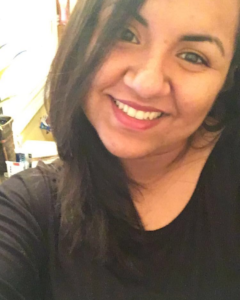
Yesenia Lares-Martinez
Yesenia Lares-Martinez lived in Waco during her four years of high school until she moved to Austin to attend the University of Texas, but she returns to Waco regularly to visit friends. She offers an interesting perspective because she has been exposed to the downtown areas in both Austin and Waco.
“There is definitely more diversity and things to do in downtown Austin,” Lares-Martinez said. “I feel like in downtown Waco, it’s just one street that caters more to Baylor students and the middle and upper-middle class. There should be more clubs and bars catered to different identity groups.”
These Waco millennials seem most interested in developing a lively downtown area that has entertainment and activities throughout the day and night. Millennials and their wishes, however, are only part of the picture… what about high profile office buildings? Apartments and lofts? Easily accessible parking? Or stores that carry daily essentials such as groceries and supplies?
What is it that you want from Downtown Waco? Leave a comment below. I would love to hear what you have to say.
 Rolando Rodriguez Soto was raised in Waco, TX, and he is currently attending Baylor University with plans to graduate in December 2016 with a Bachelor of Arts in Professional Writing & Rhetoric. After graduation, he hopes to work in Waco in the nonprofit sector to help realize the full potential of Waco. His long term goals include hopefully creating and publishing creative work whether that is a novel, short story or even a television show.
Rolando Rodriguez Soto was raised in Waco, TX, and he is currently attending Baylor University with plans to graduate in December 2016 with a Bachelor of Arts in Professional Writing & Rhetoric. After graduation, he hopes to work in Waco in the nonprofit sector to help realize the full potential of Waco. His long term goals include hopefully creating and publishing creative work whether that is a novel, short story or even a television show.
The Act Locally Waco blog publishes posts with a connection to these Aspirations for Waco. If you are interested in writing for the Act Locally Waco Blog, please email [email protected] for more information.
by Dena Quigley
October 15th is National Pregnancy and Infant Loss Remembrance Day. Did you know? Five years ago, I was completely and blissfully ignorant. But since then I’ve learned that one in four women will have a pregnancy that ends in either a stillbirth or a miscarriage… one in four! That means when I go to dinner with three friends, one of us should expect such a loss. Multiply that by several tables of women and this number quickly increases. It’s an unpopular conversation starter for sure, but occasionally we need to be made uncomfortable so that we can be made aware.
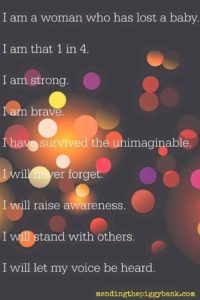 Jay Neugeboren writes, “A wife who loses a husband is called a widow. A husband who loses a wife is called a widower. A child who loses his parents is called an orphan. There is no word for a parent who loses a child. That’s how awful the loss is.” As a mother who has lost her daughter, I can relate to his words and I can attest to the loneliness that comes with such a loss. At Cradled, we often refer to the loss of a pregnancy as a “silent sorrow.” Not everyone can or is willing to relate to such a loss. I’ve had friends literally and figuratively turn their backs on my grief, leaving my husband and I to not only pick up the pieces of our tattered hearts, but to seek out and find new community. I am fortunate that I found Cradled by Love, Hope and Healing, a local group that provides support and resources for women and families experiencing the loss of a baby through miscarriage, stillbirth, early infant loss, and infertility. They gave me shelter to express my fears and sadness, and the support and love I needed to move forward.
Jay Neugeboren writes, “A wife who loses a husband is called a widow. A husband who loses a wife is called a widower. A child who loses his parents is called an orphan. There is no word for a parent who loses a child. That’s how awful the loss is.” As a mother who has lost her daughter, I can relate to his words and I can attest to the loneliness that comes with such a loss. At Cradled, we often refer to the loss of a pregnancy as a “silent sorrow.” Not everyone can or is willing to relate to such a loss. I’ve had friends literally and figuratively turn their backs on my grief, leaving my husband and I to not only pick up the pieces of our tattered hearts, but to seek out and find new community. I am fortunate that I found Cradled by Love, Hope and Healing, a local group that provides support and resources for women and families experiencing the loss of a baby through miscarriage, stillbirth, early infant loss, and infertility. They gave me shelter to express my fears and sadness, and the support and love I needed to move forward.
At Cradled, we are not happy to meet you or have you attend a support group, because that means you have suffered as no parent should suffer. But we will meet you in your grief and loss and walk with you through your journey. We offer empathy, and are willing to climb down into the hole with you, partake in your silent sorrow, and share our experiences along with other practical techniques to help ensure that you won’t be in the hole always. For some families this journey is relatively short, and for others who come to Cradled, we walk a mile, and then a mile more, and another if needed. It is an honor to be with them.
To the other three women who never experience a loss, we, the one in four, celebrate your successful pregnancies with you. You deserve happiness and joy through the life of your baby. All we ask is that you do not forget our babies. Our babies meant just as much to us as yours do to you. We understand that it is difficult to know what to say, but sometimes “I’m sorry, I will always remember” is just enough.

If you, or someone you know, is one in four, please know that Cradled is here for you. If your loss was yesterday, last year or last decade, we are ready to listen to your story. Please visit our website at Cradled.org for more information about upcoming events and support groups.
 Dena Quigley is a recent graduate of Baylor University having earned her PhD in Education. She is a wife and a mother of two beautiful boys on earth and a daughter in heaven. She has been a volunteer with Cradled by Love, Hope and Healing since 2013, and regularly co-leads support groups and is currently help to develop new curriculum.
Dena Quigley is a recent graduate of Baylor University having earned her PhD in Education. She is a wife and a mother of two beautiful boys on earth and a daughter in heaven. She has been a volunteer with Cradled by Love, Hope and Healing since 2013, and regularly co-leads support groups and is currently help to develop new curriculum.
The Act Locally Waco blog publishes posts with a connection to these aspirations for Waco. If you are interested in writing for the Act Locally Waco Blog, please email [email protected] for more information.
